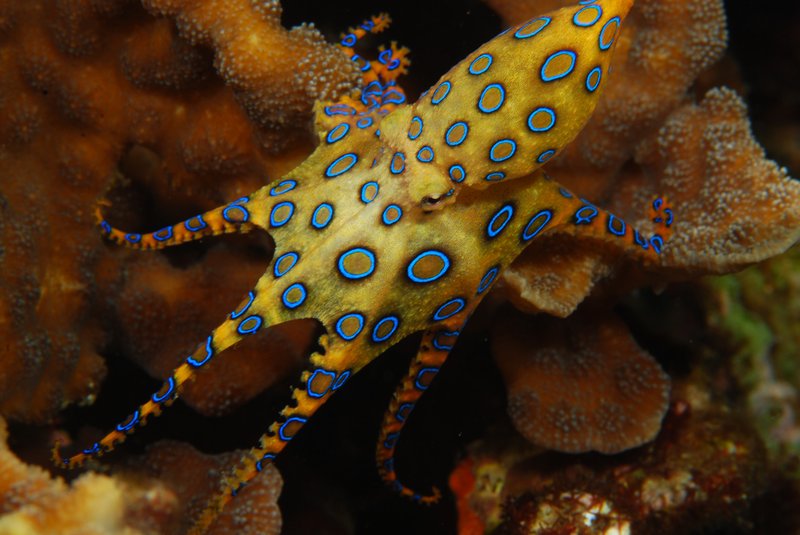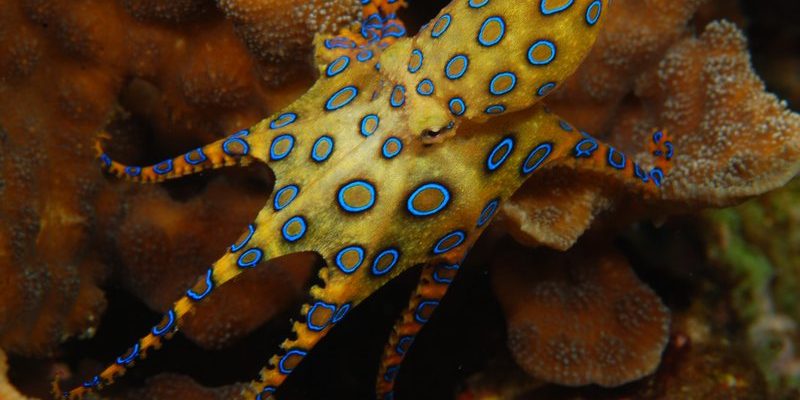
Blue-ringed octopuses are found in the Pacific and Indian Oceans, living in shallow waters and coral reefs. They’re not just beautiful; they’re also equipped with a potent venom that helps them hunt and protect themselves. Understanding their diet and feeding habits can give us insight into their role in the marine ecosystem. So, grab your curiosity cap, and let’s explore how these little wonders eat and survive beneath the waves!
What Do Blue-Ringed Octopuses Eat?
Blue-ringed octopuses are primarily carnivorous, which means they feast on other animals. Their menu mainly includes small crustaceans and fish. Some of their favorite snacks are:
- Crabs – Their tough shells don’t stand a chance against a blue-ringed octopus.
- Shrimp – These little critters are a tasty treat that’s easy to catch.
- Small fish – Blue-ringed octopuses have a knack for ambushing small fish as they swim by.
You might be surprised at how they capture their prey. Blue-ringed octopuses use their quick reflexes and impressive camouflage to blend into their surroundings, waiting patiently for the right moment. Once they spot a meal, they can strike with incredible speed. Here’s the thing: they don’t just grab their food; they use their venom to paralyze their catch, making it much easier to consume.
How Do They Capture Their Food?
The hunting technique of blue-ringed octopuses is a mix of strategy and stealth. They have specialized tentacles covered with suckers that help them grab onto slippery prey. But it’s not all about strength; these octopuses are intelligent hunters. They can plan their approach, using the terrain to their advantage.
When they hunt, they often rely on a method known as *ambush predation*. Imagine lying in wait for your food to come to you. They will sometimes bury themselves in sand or hide among rocks, staying still, and then spring into action. Their sudden movement and ability to camouflage can be quite mesmerizing, like an underwater magician revealing their hidden tricks.
The Role of Venom in Feeding
One of the most intriguing aspects of the blue-ringed octopus is its venom. While many creatures have defenses, the blue-ringed octopus uses venom both offensively and defensively. Their venom contains toxins that can quickly paralyze prey, making it easier for the octopus to swallow them whole.
The venom works by blocking nerve signals, causing paralysis. This means that once a crab or shrimp is bitten, it can’t escape. You might say that their venom is like a superhero’s secret weapon, allowing these tiny creatures to take down meals much larger than themselves. But that same venom also serves as a warning to predators—after all, they don’t want to be dinner either!
Feeding Frequency and Behavior
You might be wondering how often blue-ringed octopuses eat. Like many animals, their feeding habits can vary based on availability of food. Generally, they hunt several times a week but can go without food for a few days if necessary. Their ability to store fat allows them to survive during times when prey is scarce.
Feeding can also be a social event—though not in the traditional sense. Blue-ringed octopuses are solitary creatures, but their feeding actions can attract other animals. When they make a catch, the splashes and movement might bring curious predators closer, which can be a risk for the octopus.
Impact of Diet on Ecosystem
The diet of blue-ringed octopuses plays a significant role in their ecosystem. By preying on crustaceans and small fish, they help control their populations. This balance is crucial in maintaining the health of coral reefs and the marine environment. If blue-ringed octopuses were to disappear, we might see an overpopulation of certain species, leading to further ecological problems.
Moreover, by being prey themselves for larger fish and seabirds, blue-ringed octopuses contribute to the food web. Every creature has its place, and the blue-ringed octopus is no exception. They may be small, but their role is mighty!
The blue-ringed octopus is more than just a pretty face in the ocean; its diet and feeding habits are extraordinary. From its clever hunting techniques to the use of venom as both a weapon and a defense mechanism, this little creature demonstrates the wonders of nature’s adaptations. Understanding how they eat not only highlights their fascinating biology but also underscores their importance in marine ecosystems.
So, next time you hear about the blue-ringed octopus, remember that there’s a world of complexity behind those striking blue rings. They may be tiny, but they pack a punch when it comes to survival in the wild. Isn’t it amazing how nature works?

